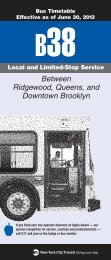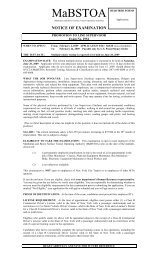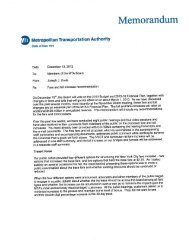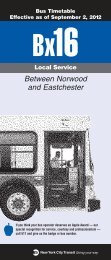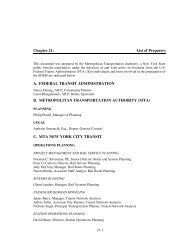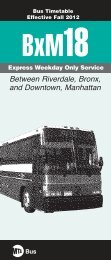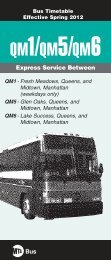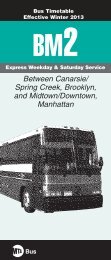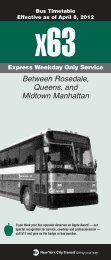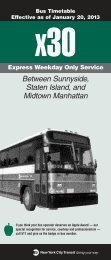Greening Mass Transit & Metro Regions: The Final Report - MTA
Greening Mass Transit & Metro Regions: The Final Report - MTA
Greening Mass Transit & Metro Regions: The Final Report - MTA
Create successful ePaper yourself
Turn your PDF publications into a flip-book with our unique Google optimized e-Paper software.
Profile of <strong>The</strong> <strong>Metro</strong>politan Transportation Authority<br />
Elliot G. Sander, <strong>MTA</strong> Executive Director and CEO<br />
<strong>The</strong> <strong>MTA</strong> is North America’s largest mass transit network, serving 14.7 million people<br />
across a 5,000-square-mile region straddling downstate New York and Southern<br />
Connecticut. <strong>The</strong> <strong>MTA</strong> is governed by a 17-member board nominated by the Governor<br />
of New York and confirmed by the New York State Senate. <strong>MTA</strong> trains, subways and buses carry over 8.5 million riders per<br />
day; <strong>MTA</strong> Bridges and Tunnels handle over 857,000 daily crossings. <strong>The</strong> <strong>MTA</strong> system provides over 2.6 billion customer<br />
trips per year.<br />
<strong>MTA</strong> Agencies<br />
<strong>MTA</strong> New York City <strong>Transit</strong> operates a subway system with 26 lines, 468 stations and 6,485 cars; a bus system with<br />
4,576 buses and 243 routes; and Staten Island Railroad with 22 stations and 64 cars. Ridership is approximately seven<br />
million daily and over 2.3 billion annually.<br />
<strong>MTA</strong> Long Island Rail Road the largest commuter railroad in North America, operates 11 rail lines with 124 stations and<br />
1,153 cars. Ridership is approximately 289,000 daily and over 82 million annually.<br />
<strong>MTA</strong> Long Island Bus operates one of North America’s largest all-CNG fleets with 330 buses on 54 fixed routes.<br />
Ridership is approximately 109,000 daily and over 32 million annually.<br />
<strong>MTA</strong> <strong>Metro</strong>-North Railroad includes five rail lines with 120 stations and 1,195 cars. Ridership is approximately 265,000<br />
daily and over 80 million annually.<br />
<strong>MTA</strong> Bridges and Tunnels operates two tunnels and seven bridges. Vehicle crossings are approximately 857,000 daily<br />
and over 304 million annually.<br />
<strong>MTA</strong> Capital Construction manages the construction of the <strong>MTA</strong>’s major expansion projects, including East Side Access,<br />
Second Avenue Subway and 7 Line Extension, as well as the “Downtown Mobility Projects,” the Fulton Street <strong>Transit</strong> Center<br />
and South Ferry Terminal.<br />
<strong>MTA</strong> Bus Company, formed out of seven private lines in 2006, operates 1,354 buses on 81 local and express routes.<br />
Ridership is approximately 368,000 daily and over 109 million annually.<br />
Energy/Carbon – Traction Power <strong>Report</strong><br />
<strong>The</strong> <strong>MTA</strong> provides over 8.5 million<br />
passenger trips daily with an energy<br />
efficiency equivalent to 100 mpg, over<br />
twice the efficiency of today’s most<br />
advanced hybrid cars.<br />
<strong>MTA</strong> traction power use is significant. Traction power alone comprises approximately 2,800 GWh per year, at an electricity<br />
cost of approximately $294 million annually. <strong>MTA</strong> NYC <strong>Transit</strong> consumes about 80% (2,240 GWh) of the annual <strong>MTA</strong><br />
traction power usage. Technologies and other innovative operating techniques to reduce this energy consumption (and subsequent<br />
significant CO2 emissions) are examined. <strong>The</strong> methods utilized to reduce traction energy consumption are broken<br />
down into two categories:<br />
• Regenerative energy management techniques<br />
• <strong>Mass</strong> reduction of train car components<br />
Regenerative energy management techniques include on-board energy storage, trackside energy storage, operational<br />
enhancements such as start/stop synchronization, and software modifications for train cars to better utilize regenerated<br />
energy. <strong>Mass</strong>-reduction techniques include elimination of redundant components, substituting lighter materials such as aluminum<br />
for steel and developing innovative design optimization techniques to enable identical structural performance with<br />
reduced weight.<br />
Additional information on this subject is available at www.mta.info/environment.<br />
Energy/Carbon – Renewable Energy <strong>Report</strong><br />
<strong>The</strong> <strong>MTA</strong> has established a goal to increase its renewable energy use to 7% by 2015, through both distributed generation<br />
and green power purchases (renewable energy credits). This is a significant challenge, as any transit agency has an<br />
extremely high energy intensity due to the traction power demands, and <strong>MTA</strong> is no exception. <strong>MTA</strong>’s power demand was<br />
approximately 3.5 million MWh (megawatt hours), approximately 80% of which is traction power demand. <strong>MTA</strong> currently<br />
purchases wind energy renewable energy credits (RECs) from the New York Power Authority (NYPA) and has nearly 500<br />
81



